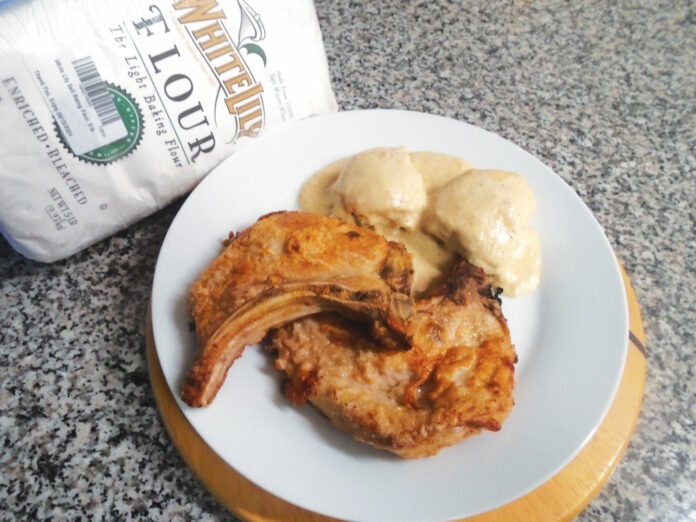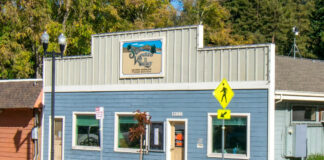“Almost Heaven, West Virginia, Blue Ridge Mountains, Shenandoah River,” … sang vocalist John Denver
As a little girl from the “southside” of Aberdeen, Wash., almost everything I played with was handmade and we ate “at home,” and almost every meal included my aunt Betty’s buttermilk biscuits and gravy made from the drippings of chicken, pork or sometimes beef; not a drop was wasted.
Aunt Betty, born in the Blue Ridge Mountains of West Virginia, moved with the family to Aberdeen when she was 19 years old. She somehow managed to buy a two-story, Douglas fir shingled boarding house where she prepared three meals a day for eight hungry boarders. I was one of the lucky few whose family owned their own home. World news was listened to on the radio at 5:30 each evening as menfolk were home from work by that time. Neighbors were like family.
Families ate dinner together, asked to be excused from the table, if and only if, you had finished everything on your plate, and you had to be in the house before dark and in bed by eight each evening, except for the weekends when an extra hour was added before bedtime.
No one wore Levis, played golf or had a credit card, and only on a special occasion did my aunt use the neighbor’s phone.
In kindergarten when Christmas was nearing, we made our paper chains to decorate our trees from red and green strips of craft paper, which we glued together with a mixture of flour and water. LePage glue had to be purchased, and our school didn’t have the money, which, in retrospect, was probably a good thing. I remember licking my fingers and loving the taste of that flour concoction, and LePage glue tasted even better to a kid.
My dresses and pajamas were made by my aunt from chicken feed, sugar and flour sacks that had printed patterns; from the plain white sacks, she made dish towels and aprons for herself. “Use it up, wear it out, make it do, or do without” was the motto coming out of World War II.
I remember the white sacks came with a red band across the front of the sack, which faded away with each washing. This flour was bleached, made whiter by chemicals and was more acidic due to the benzoyl peroxide or chlorine gas used in this process.
In the 1890s, the process of milling flour using steel rollers caused anemia, as the vitamins thiamin, niacin and iron were all removed. In 1941, the U.S. mandated that all white flour be enriched with those nutrients being added back in.
Today, our flour choices are many. Ranging from all-purpose flour to gluten-free flour, each with a unique purpose of its own.
All-purpose, means just that. It can be used anywhere the word “flour” is called for.
Cake flour, with the lowest protein content (lack of gluten-forming proteins), results in more tender cakes and with a higher rise in biscuits and scones.
Pastry flour is made by blending 1 and 1/3 cups of all-purpose flour with 2/3 cup cake flour. This is the blend I use for my biscuits, cakes, tarts and pies. You can’t go wrong with this blend.
Self-rising flour has added salt and baking powder to its mix. (You can make your own by sifting 2 cups all-purpose flour with 1-1/2 tsp. baking powder and 1/2 tsp. salt.) This flour is milled in the southern states’ mills using their low protein grown wheat. White Lily Self-Rising Flour is the southern brand that I purchase online and is twice the cost of grocery brands elsewhere. I only use this costly flour for certain biscuits and cakes, and I keep the flour in the freezer in a tightly sealed container.
Bread flour is the strongest flour providing the best structural support. Best for yeasted breads where gasses are produced, making for better volume and a chewier crust.
Whole Wheat flour is higher in protein due to its milling process and tends to produce heavier and denser baked goods. Because of its higher oil content, this flour is more perishable than white and has a shelf life of three months and should be kept in the freezer.
Gluten-free flours are usually blended with rice flour, tapioca and potato starch.
My Lily’s flour arrived yesterday, and I immediately thought of my buttermilk biscuits with pork chops and pork chop gravy, which I am making for tonight’s dinner. Adding a little sage spice to the gravy takes me back to those country roads of West Virginia where my aunt and family were born. Yummy!
Colly’s Buttermilk Biscuits
(Taken from three different recipes over time.)
Makes 10 two-inch biscuits.
2 cups Lily’s self-rising flour (or make your own from the recipe above)
4 Tbsp. room temperature butter cut into small cubes
¼ cup cream cheese, at room temperature
¾ cup whole buttermilk
Preheat oven to 500deg. with rack in middle of oven.
Add flour, butter and cream cheese into a large bowl and between two fingers, snap in the butter and cheese until mixture resembles cottage cheese. It will be chunky with some loose flour.
Make a well in the center and pour in buttermilk. Using a spatula or your hands, mix in the buttermilk. The dough will be very sticky and messy.
Flour your breadboard and dump dough on top.
Flour the top of the dough and your rolling pin well and roll out dough to 1-1/4 inch thickness.
Using a 2-inch cookie cutter, cut biscuits and place touching each other, on a parchment-lined baking pan. Brush tops with melted butter.
Place in oven and IMMEDIATELY reduce heat to 450deg. Bake 16-18 minutes or until light brown. Rotate pan once while baking.
Colly Gruczelak, a Ben Lomond resident, loves people and loves to cook. Contact her at cz****@*****st.net.













